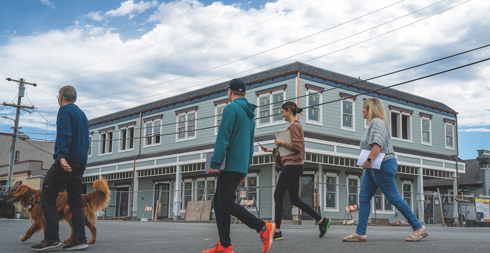The article below originally appeared in the Half Moon Bay Review and is being reprinted with permission.

Construction continues at 600 Mill St. in downtown Half Moon Bay. The building is to house College of San Mateo classrooms.
Half Moon Bay planners last week approved College of San Mateo Community College District plans to move forward on opening two classrooms downtown. City and college officials believe the new space will provide educational opportunities for Coastsiders unable to access the main campus in San Mateo.
The proposed Coastside Education Center, an extension of the College of San Mateo, will teach students at the corner of Mill and Purissima streets. Last week the Half Moon Bay Planning Commission approved two permits to make the facility possible. The center will be part of a larger building still under construction at the intersection.
In October 2020, the commission approved a Coastal Development Permit, architectural review, and parking exception that allowed a two-story mixed-use building to be built on the site. The building will feature five residential units on the second floor and two commercial spaces on the first floor. The commercial spaces were approved without specific tenants.
About 12 years ago, CSM rented space at Shoreline Station that cost the school about $130,000 a year. The new plans call for two classrooms and two offices. The college intends to have a soft opening in the fall and be fully operational by spring 2024.
“It’s kind of a once-in-a-decade opportunity to provide local classrooms and deliver valuable education opportunities to our residents,” Commissioner Steve Ruddock said. “It’s something in our downtown that will support local residents.”
The larger classroom could hold up to 22 students, and both classrooms can hold a maximum of 45 students, faculty and staff. About one or two staff would be onsite on average, with four staff at maximum. The proposed hours of operation are 8 a.m. to 7 p.m. on Monday through Thursday, from 8 a.m. to 6 p.m. on Friday and from 8 a.m. and 5 p.m. on Saturday for community events.
Richard Storti, the acting president of CSM, said the move represented a renewed connection to the coast.
He noted more than 65 percent of the school’s enrollment consists of students of color.
“Community colleges provide educational opportunities that are truly transformational in the lives of students and also in the community served,” he said. “CSM serves the diverse educational, economic, social and cultural needs of students.
“Establishing community college classroom space in Half Moon Bay will improve access for residents by helping to remove transportation barriers and improve access to offerings,” he said.
Karen Decker, Half Moon Bay’s economic and community vitality manager, said investing in local education is a step in the right direction toward diversifying the city’s economy and advancing people toward higher-wage jobs. She said one-third of Coastside adults have not attended college, and nearly 10 percent have less than a high school education.
“When we have limited job opportunities and low wages, our region is less
competitive and it’s harder to attract graduates of Half Moon Bay High School who otherwise may want to stay in the region but feel like they have to go to another area to have a high impact, high wage job,” Decker said. “While online classes are a really nice option, they’re not for everybody. And as Coastside residents know, our digital infrastructure is really lacking in terms of reliability.”
Community Development Director Jill Ekas said that in order to allow these satellite classrooms in Half Moon Bay’s commercial-downtown zoning district, the city must grant two permits: a use permit and a continuance of a parking exemption. In order to grant a use permit, the Planning Commission had to determine that the classrooms wouldn’t be detrimental to public welfare or damage property, according to a staff report.
The commission had to make another parking exemption in addition to the one it made in 2020. According to a staff report, school faculty and staff will park in five spaces on Miramontes Street. As part of course registrations, students will be directed to park on Church Street one block to the west. Commissioner Margaret Gossett noted that the classrooms aren’t expected to be packed during downtown’s peak business hours or holiday weekends.
Ekas noted staff had received concerns about the poor quality of the crosswalk at the intersection of Mill and Purissima streets. The city will likely install two more stop signs at the intersection and reduce the crosswalk markings.